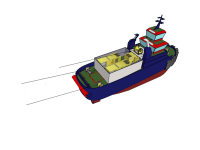Multi-function PowerhouseTug & Barge (PTB) system is a novel design that utilizes electric propulsion in the barge and a tugboat with a set of generators as a power pack. The control will be onboard the PowerhouseTug.
This concept will have propulsion and operational advantage of a ship compounded with commercial advantage of a tug & barge system. The greatest advantage of this concept is that the tug can be designed to serve as a traditional tow boat, pusher in ATB configuration, as well as a PowerhouseTug in PTB configuration, serving all kinds of barges and vessels.
Under the new PTB concept electric propulsion gears (preferably azimuth drive) will be used onboard the barge with no propulsion power onboard. A PowerhouseTug with a set of generators and a secondary electric propulsion gear onboard will be attached at the bow of the barge to work as a power pack for the barge. Propulsion gear onboard PowerhouseTug contributes to its independent operation.
Simplest connection between the PowerhouseTug and barge may be achieved through a suitable fender at the stern of the tug, tow cable and two guy wires from auto-tensioning winches.
Technical Advantages:
Increased propulsion efficiency due to:
Maximization of propulsive gear size on barge
Tug at forward end resulting in added length & better angle of entrance
Reduced tug-barge transitional loss
Better design of stern of the barge
Smaller and simpler articulation system
Ease in environmental compliance
Powerhouse tug with propulsion gears for independent operation
Barge with wireless-controlled generators for emergency operations
Operational Advantages:
No line of sight issue
Flexible operation:
in PTB configuration or
quick switching to towing/pushing/berthing mode
Tug and barge as independent units
Remote operation of barge from tug or shore
Commercial Advantages:
Smaller crewing need
Lower freeboard, resulting in increased cargo capacity
Smaller machinery space, thus increased cargo capacity
Higher Propulsive efficiency, saving fuel
Cheaper articulation system
No notch needed saving significant investment
Increased utility & reduced downtime from build-in flexibility
Additional fuel bunker in barge for higher tug endurance
No superstructure on barge saving investment
Low overall cost
Quicker return on investment
Cargo Capacity Increase:
Manned vessel: 730ft Loa, 78ft B, 45 D, 27.5ft d
35000dwt
Unmanned Barge: 730ft Loa, 78ft B, 45 D, 31.85ft d
41400dwt
18.25% increase in cargo capacity
Crewing cost reduction for an example vessel:
35000dwt cargo vessel: 730ft Loa, 78ft B, 45 D
Crew need: 22
35000dwt Tug & Barge: 730ft Loa, 78ft B, 45 D
Crew need: 13
41% reduction in crew requirement
Cost Saving in Hull & Superstructure:
25% reduction in freeboard
Around 6.4% of depth reduction
Hull weight saving 3%
41% reduction in cost of superstructure
Cost of Propulsion and related systems:
Expected a saving 500Tons in weight
Propulsion system: No gearbox needed
Maneuvering system: Saving of bow thruster
Cost of Regulatory requirements:
Bilge & Ballast system: 75% saving
Firefighting & Safety Appliances: 40% saving
Life-cycle Cost Savings:
Crewing: Over 41% reduction Fuel: Lower than ship; way lower than Tug & Barge
Maintenance Cost: Less than 50% of ship
Video
Like this entry?
-
About the Entrant
- Name:Mizanur Majumder
- Type of entry:individual
- Software used for this entry:AutoCad, GoogleSketchUp
- Patent status:pending








